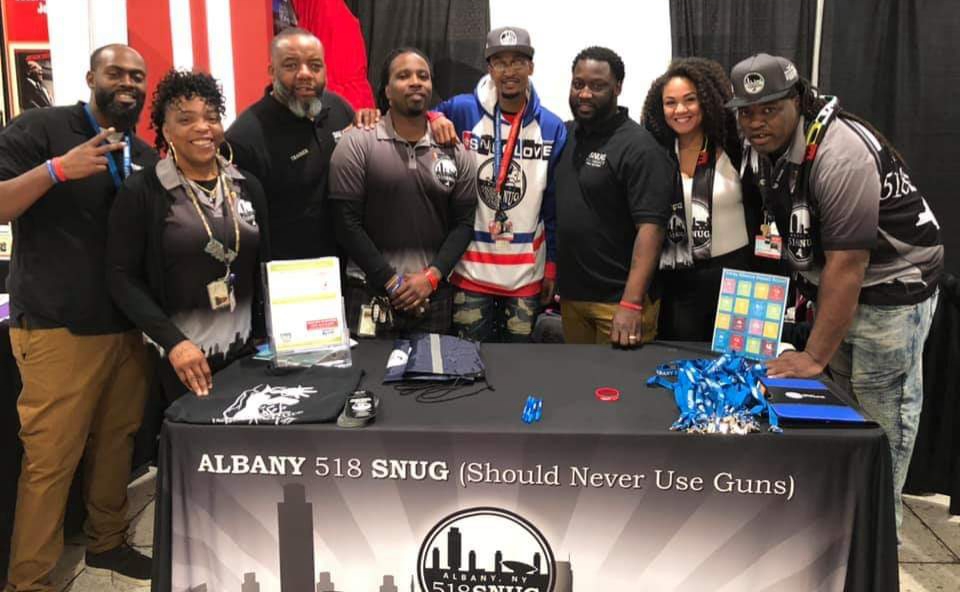
Food Pantries of the Capital Region.
We strive to bring you closer to the musicians and bands you know and love in the Capital Region. But that starts with the desire to bring people closer together period, and nothing brings us closer than our compassion during the holiday season. Through donating to our local food pantries and charity drives, and volunteering at soup kitchens, our good natures do shine through. Tomorrow is the fourth annual Foodstock, a great concert for a great cause. So today, I talk with Natasha Pernicka, the Executive Director of The Food Pantries for the Capital District, a coalition of 65 food pantries in the Albany, Rensselaer, Schenectady and Saratoga Counties. Join us for a bird’s eye view of hunger in the Capital District, and how your help matters so much.
RRX: Welcome, Natasha. I’d like to start off with the big picture problem. I read a post from your Facebook page that said, among other thing, that 89,850 (2016 Feeding America) people in the Capital District struggle with hunger. If you can, talk about what it means to be “food insecure,” and put this figure into perspective for people.
NP: People are shocked when they learn that more than 1 in 10 of our community members are struggling with food insecurity. The 89,850 includes more than 27,000 children in the Capital Region. Food insecurity exists when people don’t have the resources for or access to nutritious food for a healthy life. It’s not just the homeless person begging for change on the corner, its families, working people, and seniors who are retired on a very limited income. Its veterans and single parents, people juggling three part time jobs, and those without transportation and living in an area without grocery stores, having to make do with corner stores and fast food.
RRX: We have a region that is a mix of urban and rural landscapes. I’m sure the fight against hunger, while universal, presents different challenges depending upon where it’s happening. Are there any challenges specific to rural Capital Region? Anything specific to the Tri-Cities?
NP: There are many challenges that come up for people struggling with food insecurity. Food deserts are one. USDA Defines Food Deserts as parts of the country vapid of fresh fruit, vegetables, and other healthful whole foods, usually found in impoverished areas. This is largely due to a lack of grocery stores, farmers’ markets, and healthy food providers. Food deserts exist in both urban and rural areas in the Capital Region. Thankfully there are food pantries throughout the region and many are making efforts to provide more fresh produce.
Another challenge is transportation. A typical food pantry provides food for a minimum of three days for an individual or family to take home. Some rural pantries recognize that a person may need to travel 20 miles to get to the food pantry and they will provide 10-14 days’ worth of grocery items to help reduce the burden of transportation. In urban areas, some people rely on special transportation services and the time and coordination it can take just to schedule a visit to a food pantry can take up an entire morning.
Time can be very limited when you don’t have enough to get your basic needs covered and you are reacting to crisis after crisis, stress after stress.
One of the benefits of the food pantry system in the Capital Region is that due to the nature of the collaboration through The Food Pantries coalition, service coordination efforts help ensure that those looking for assistance find the help that they need.\

Behind the scenes at a food pantry.
RRX: It’s the beginning of the holiday season now. I know a lot of people, including myself, are looking for a way to give, and I can imagine it’s coming on feast season for local food pantries. But are there specific dates, months, or seasons that trend lean? If you could add an extra “boomerang month” for people to double-back and give again, when would that be, and why?
NP: That’s a great question. We are so grateful for all of the people reaching out to help right now during the holidays but it is important to raise awareness that hunger is a year round concern for many. After the holidays and summer are two other good times to get involved. Many pantries provide holiday programs so after the holidays restocking the shelves helps.
During the summer children are home from school. Families who rely on school lunch and breakfast programs often turn to food pantries to help ease the extra burden during this time. Donations of food that is easy for children to prepare helps families stretch their resources.
RRX: When people think of food pantries and food drives, they feel a connection to giving, the physical holding of food in their hands that they are giving to a hungry person; it’s visceral, something you can’t get by putting a bill in a jar. Yet that bill might actually go farther, all things considered. How do you weigh the donation experience of giving “in-kind” donations (cans, boxes, etc.) versus giving cash?
NP: I think that most people don’t realize that of the millions of pounds of food that is distributed each year, most is sourced from the food bank and has a cost associated with it. If you donate cash to food pantries the dollar can go much farther than if you buy food at the grocery store to donate. $1 can provide up to 6.25 pounds of food! This goes a long way when you consider our local pantries provided food for 3.3 million meals last year and this year is on track for similar community need.
Pantries do appreciate food as well. Not all of the items in need are always available at the food bank. If you are donating to a particular food pantry asking what they are in need of helps. And don’t be afraid to think outside the “box of pasta”. People are in need of personal hygiene items like soap, deodorant, toothpaste, laundry detergent, feminine hygiene products, diapers, and more!
RRX: Coming from the last question, we know that giving donations, physical ones, connect people intimately to the people they are helping. The experience of that kind of giving is high beyond the benefit of getting food to people. How can we capitalize on it to get awareness, especially given the sheer magnitude of hunger and food insecurity even just in our area? How do we make the community care as actively in the off-season as they care in the on-season?
NP: We raise awareness throughout the year through outreach programs and public speaking and are actively building partnerships to help fill the gap with organizations and people who care. Invite us to come and speak to your community group or in your workplace! Get involved by volunteering! An easy way to give throughout the year is by setting up automatic online donations – $20 a month equates to $240 a year which can provide 1,500 pounds of food!
The more people learn about food insecurity the more we can break down stigma and recognize that it could be your neighbor down the street or the assistant that works in your doctor’s office. The more we recognize the reality that far too many of our community members face, when we do have a chance to make a difference, we get involved. Every dollar and pound of food donated, every hour of time spent volunteering, and every action in the greater community adds up!
Events such as Foodstock help us meet new friends too! We are grateful for community members hosting events to help us raise awareness and support.
RRX: I have three hundred-dollar bills, and I’m in the supermarket. I didn’t do a smart thing, like call my local food pantry ahead of time; I just want to spend money. My first hundred, I’m going to spend on “the stuff they always need.” Second hundred goes to “the stuff that no one thinks to get.” The third hundred goes to “treats, cause everyone should get treats once in a while.” … Help me spend my money. What am I buying which each bill?
NP: Ha ha love this! Ok, well this is a tough question because every pantry serves its own neighborhood with their unique tastes but this will be a good start!
First hundred on pantry staples like peanut butter, canned tuna fish, canned soups and stews, canned vegetables and fruits, cereal, rice, pasta, and pasta sauce.
Second hundred on personal hygiene products like toilet paper, and the items that I mentioned above.
Third hundred on coffee, dried herbs and spices (a treat to have tasty food), and whatever you enjoy!
I want to add that while food drives are not ideal for perishable food items, if you are donating directly or through The Food Pantries for the Capital District, fresh produce is needed as well as meats. In a survey of pantry patrons that we conducted in partnership with Dr. Cynthia Bott of Siena College, meat scored number one as the item people would like more of available through food pantries. Just make sure the pantry has a refrigerator or freezer ahead of time!

Volunteers make it happen.
RRX: Have there been collaborations with other stakeholders, like grocery stores, farms, restaurants, etc. – that have shown promise in building any local food-security infrastructures? Any stand-out stakeholders you’d want to recognize?
NP: Food pantries are largely supported by charity through individuals, businesses, foundations, and other community organizations. We are lucky that New York State is taking food insecurity and provides resources to community food assistance providers as well. While the list of collaborative partners and stakeholders is too long to list here, I want to mention that we will be holding our 2nd Food Summit the spring of 2019 to bring together stakeholders to share best practices, research, and innovations in community food assistance efforts. We expect more than 250 people to attend and come away with new friends and ideas, partnerships strengthened, and a renewed energy to keep up our local efforts to fight hunger.
For more information about the 2019 Food Summit, to volunteer or donate, to schedule a guest speaker, or if you need food assistance, please contact us at pantries@thefoodpantries.org or 518-458-1167.
Be sure to check out Foodstock on Sunday, November 4th at the Rustic Barn Pub in Spiegeltown from 2-8 pm, to benefit The Food Pantries for the Capital District. Enjoy music by The Barn Boys, TyEs, Off the Record, Diva & the Dirty Boys, Soulsky, Back 40 Band and the Greasy Fingers Band.



 RadioRadioX
RadioRadioX